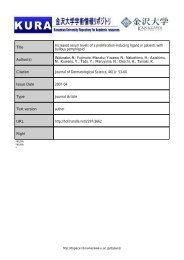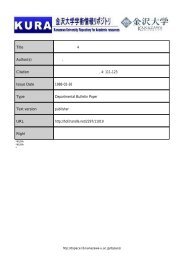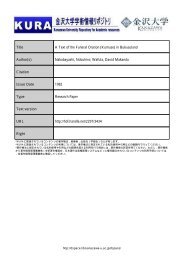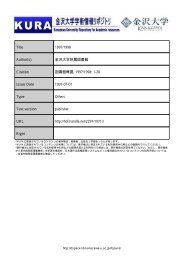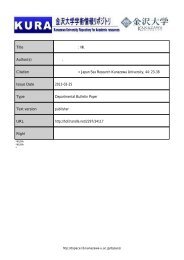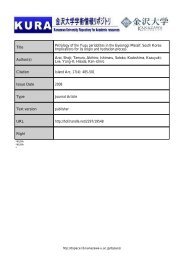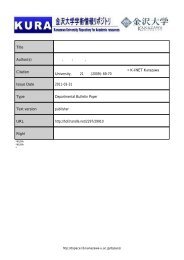Title The Study on Myanmar trade ware:Martaban Jar and ... - 金沢大学
Title The Study on Myanmar trade ware:Martaban Jar and ... - 金沢大学
Title The Study on Myanmar trade ware:Martaban Jar and ... - 金沢大学
You also want an ePaper? Increase the reach of your titles
YUMPU automatically turns print PDFs into web optimized ePapers that Google loves.
<strong>金沢大学</strong>考古学紀要 30 2009, 101-136. <str<strong>on</strong>g>The</str<strong>on</strong>g> study of <strong>Myanmar</strong> <strong>trade</strong> <strong>ware</strong> : <strong>Martaban</strong> jar <strong>and</strong> white dish<br />
<str<strong>on</strong>g>The</str<strong>on</strong>g> thick wall is made of brick composed of s<strong>and</strong>y red clay with<br />
pebbles as am inclusi<strong>on</strong>. <str<strong>on</strong>g>The</str<strong>on</strong>g> bricks measurement about 5cm<br />
thick 130 wide, were laid flat <strong>and</strong> were l<strong>on</strong>g enough to reach<br />
across the width of the wall.<br />
<str<strong>on</strong>g>The</str<strong>on</strong>g> firing chamber is larger than kiln#2, #3 <strong>and</strong> #5, being about<br />
150cm at its greatest diameter with the upper opening 90cm<br />
across. Patchy green coloured glaze covers the inner surface.<br />
<str<strong>on</strong>g>The</str<strong>on</strong>g> fire-hole is relatively large measuring 65cm wide. As<br />
with <strong>on</strong>e of the other kilns it appeared that the bricks had been<br />
corbelled to create the enclosing curve of the firing chamber.<br />
<str<strong>on</strong>g>The</str<strong>on</strong>g> axis is 270 degrees (similar to that of kiln#3 <strong>and</strong> #6, <strong>and</strong><br />
opposite to kiln#1, #2 <strong>and</strong> #5). This is the <strong>on</strong>ly <strong>on</strong>e of the kilns<br />
to have no rear vent. <str<strong>on</strong>g>The</str<strong>on</strong>g>re are no holes or glaze deposit <strong>on</strong> the<br />
top surface (which may have been eroded).<br />
A few beads, tubes <strong>and</strong> lumps of yellow, green, blue, black <strong>and</strong><br />
brown glass were found in the vicinity of the kiln. <str<strong>on</strong>g>The</str<strong>on</strong>g> small<br />
amount of glass found in associati<strong>on</strong> with the kiln may have<br />
been due to its locati<strong>on</strong> <strong>on</strong> the boundary of the m<strong>on</strong>astery <strong>and</strong><br />
near a frequently used path.<br />
Kiln#5 (Fig.15.e): (GPS.N:21 º 08’ 55.6”, E: 94 º 51’ 33.7”) is<br />
located about 170m west of Abeyadana Temple. <str<strong>on</strong>g>The</str<strong>on</strong>g> size <strong>and</strong><br />
shape of the kiln (fig.66.a) is the same as kiln#2, #3 <strong>and</strong> #6 <strong>and</strong><br />
it has an axis of 100 degrees. <str<strong>on</strong>g>The</str<strong>on</strong>g> kiln has inside <strong>and</strong> outside<br />
brick walls, <strong>and</strong> red s<strong>and</strong>y clay was used as a fill between them.<br />
<str<strong>on</strong>g>The</str<strong>on</strong>g> outer wall bricks measure 11cm wide by 4cm thick by<br />
approximately 20cm l<strong>on</strong>g, <strong>and</strong> the wall thickness at its widest<br />
is about 60cm.<str<strong>on</strong>g>The</str<strong>on</strong>g>re are signs that the upper part of the kiln<br />
had been repaired or rebuilt during the period of operati<strong>on</strong> <strong>and</strong><br />
it appears from the inner curvature <strong>and</strong> raw top surface that<br />
some of the upper is eroded <strong>and</strong> that no original top remains.<br />
However, a few globules of glass can be seen in gaps or cracks<br />
in the wall, this apparently originating from glass that penetrated<br />
the wall through the top of the kiln. <str<strong>on</strong>g>The</str<strong>on</strong>g>re are no holes in the top<br />
surface. <str<strong>on</strong>g>The</str<strong>on</strong>g> firing chamber is slightly smaller than kiln #2 <strong>and</strong><br />
#3 <strong>and</strong> the inner face has a whitish green slag. Both the fire-hole<br />
<strong>and</strong> vent aperture have thin skirt extensi<strong>on</strong>s which were made<br />
from shaped clay (which hardened after firing).<br />
<str<strong>on</strong>g>The</str<strong>on</strong>g> area around the kiln was scattered with thous<strong>and</strong>s of<br />
sherds in heaps (a typical by product of digging for gold)<br />
ranging from orange earthern<strong>ware</strong> pottery vessels including<br />
many kendi to dark gray near st<strong>on</strong>e<strong>ware</strong> objects. Some of the<br />
sherds had transparent or bluish glaze <strong>on</strong> <strong>on</strong>e side. Many others<br />
had a thick layer up to 1.5cmthick of glaze- glass <strong>on</strong> the bottom<br />
of the inside or around the mouth rim. In 1990 a few small<br />
blue glass beads were found <strong>on</strong> the ground surface near the<br />
kiln <strong>and</strong> in 1994 beads, tube <strong>and</strong> lumps of m<strong>on</strong>ochrome yellow,<br />
black, green, blue <strong>and</strong> brown glass were found in associati<strong>on</strong><br />
− 115 −<br />
with the kiln.<br />
About 50m to the east of kiln#5 large quantities of glass<br />
were seen <strong>and</strong> 35 beads, numerous tubes <strong>and</strong> lumps of yellow,<br />
black, green, blue, brown <strong>and</strong> white(pearl coloured) glass were<br />
collected in 1994. <str<strong>on</strong>g>The</str<strong>on</strong>g> presence of kiln brick suggested a kiln<br />
probably existed in the area.<br />
Kiln#6 (Fig.15.f): In 1994, another updraft kiln type was<br />
found by U Aung Kyaing about 500m south of Myinkaba <strong>and</strong><br />
200m west of Sein-nyet Nyi-ma temple (at GPS.N: 21 º 08’<br />
20.9”, E: 94 º 51’ 32.6”) <str<strong>on</strong>g>The</str<strong>on</strong>g> kiln is located <strong>on</strong> the slope of a<br />
hill in undulating ground <strong>on</strong> the s<strong>and</strong>y, pebbly sediment <strong>and</strong><br />
lots of petrified wood, comm<strong>on</strong> to Bagan. <str<strong>on</strong>g>The</str<strong>on</strong>g> solid mass of<br />
c<strong>on</strong>glomerate rock that exists close to the present ground surface<br />
in the area is more apparent at kiln#6 because of the disturbance<br />
due to gold diggings. <str<strong>on</strong>g>The</str<strong>on</strong>g> base of the kiln is below the surface<br />
of the c<strong>on</strong>glomerate layer meaning the kiln must have been dug<br />
into the ground rather than being built <strong>on</strong> the ground surface.<br />
<str<strong>on</strong>g>The</str<strong>on</strong>g> kiln has horseshoe -shaped ground plan (similar to kiln#4)<br />
<strong>and</strong> a top opening of 60cm diameter. <str<strong>on</strong>g>The</str<strong>on</strong>g> walls are about 35cm<br />
thick <strong>and</strong> partly built of bricks placed horiz<strong>on</strong>tally across the<br />
wall. <str<strong>on</strong>g>The</str<strong>on</strong>g> bricks measured 18cm wide, about 5.5cm thick <strong>and</strong><br />
about 32 to 35cm ling.<br />
<str<strong>on</strong>g>The</str<strong>on</strong>g> firing chamber is inclined inwards toward the top but<br />
not as enclosed or “bee-hived” as kilns #2, #3 <strong>and</strong> #5. Parts<br />
of the upper wall are displaced inwards due to fusi<strong>on</strong> <strong>and</strong> heat<br />
damage. Some repair appears to have been made to the top of<br />
the kiln where some layers of clay are very thin <strong>and</strong> may have<br />
been applied as raw slab clay rather than as formed bricks.<br />
Fill in the bottom of the kiln prevented the observati<strong>on</strong> of the<br />
floor, but about 90cm of the inner height could be seen. A rear<br />
vent of about 20cm diameter is located close to the top of the<br />
wall <strong>and</strong> it appears to exist at ground level which at that point<br />
is near the top of the wall. In this case, the vent is much higher<br />
than for kilns #2, #3 <strong>and</strong> #5. <str<strong>on</strong>g>The</str<strong>on</strong>g> axis of the kiln is 265 degrees<br />
mag. which is similar to kilns #3 <strong>and</strong> #4. Very thick amount of<br />
dark green glaze exist <strong>on</strong> the upper third of the firing chamber<br />
wall <strong>and</strong> the wall surface is very irregular. Some glaze extends<br />
to the rim of the firing chamber opening <strong>and</strong> <strong>on</strong>to the surface.<br />
Penetrati<strong>on</strong> of glaze into cracks <strong>and</strong> gaps in the wall can be<br />
seen.<br />
Around the kiln depressi<strong>on</strong>s <strong>and</strong> mounds resulting from<br />
digging unglazed <strong>ware</strong> sherds are the most comm<strong>on</strong> al<strong>on</strong>g with<br />
a few glazed sherds with a low temperature blue or brown glaze<br />
<strong>and</strong> fragments from Chinese blue <strong>and</strong> white <strong>ware</strong>s. Many of the<br />
earthern<strong>ware</strong> sherds have a whitish deposit <strong>on</strong> the surface which<br />
may be calcite causes by effect of burial in lime rich soil.<br />
Kiln#7 (Fig.15.g): <str<strong>on</strong>g>The</str<strong>on</strong>g> kiln lies about 50 yards, southeast of




